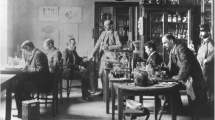Abstract
The modern age in the study of the cerebellum started 120 years ago when Cajal published his first paper with Golgi-impregnated material. In this publication, he selected the cerebellum to initiate his gigantic work aimed at unraveling the complexity of the CNS organization. It was not by chance that he selected the cerebellum but because of the occurrence of specific types of fibers, particularly climbing and mossy afferents and basket fibers. The peculiarity of these fibers offered Cajal one of the clearest situations to envision his “neuron doctrine”, which proposes that between the nerve cell processes there is no continuity, only contiguity. In 4 years of intense investigation, Cajal was able to untangle the whole cerebellar circuit, providing the roots of our present knowledge on cerebellar organization. This knowledge has greatly expanded in the last 40 years mainly because the application of new techniques, such as electron microscopy, axonal connection tracing techniques based upon axoplasmic transports, and especially modern immunohistochemical and in situ hybridization techniques allowing the correlation of the chemical constituents of the cells with their structural counterparts, as a valuable approach to better appraise function and organization of the cerebellum. These post-Cajal discoveries are briefly discussed to conclude that, even though we are still far from a complete understanding of its function, new important concepts have been developed, for instance that through its connections with the prefrontal cortex, the cerebellum does not only contribute to the planning and execution of the movement, but that has access also to higher cognitive functions.


Similar content being viewed by others
References
Cajal SR (1917) Historia de mi labor científica. In: Recuerdos de mi vida. Vol. 2, Madrid: Nicolas Moya
Cajal SR (1888) Estructura de los centros nerviosos de las aves. Rev Trim Histol Norm Patol 1:1–10
Sultan F, Bower JM (1998) Quantitative Golgi study of the rat cerebellar molecular layer interneurons using principal component analysis. J Comp Neurol 393:353–373
Leto K, Carletti B, Williams IM, Magrassi L, Rossi F (2006) Different types of cerebellar GABAergic interneurons originate from a common pool of multipotent progenitor cells. J Neurosci 26:11682–11694
Cajal SR (1888) Sobre las fibras nerviosas de la capa molecular del cerebelo. Rev Trim Histol Norm Patol 2:33–41
Cajal SR (1889) Sur l’origine et la direction des prolongations nerveuses de la couche moléculaire du cervelet. Int Msch Anat Physiol 6:158–174
Cajal SR (1889) Sobre las fibras nerviosas de la capa granulosa del cerebelo. Rev Trim Histol Norm Patol 4:107–118
Cajal SR (1890) À propos des certains éléments bipolaires du cervelet avec quelques détails nouveaux sur l’évolution des fibres cérébelleuses. Int Msch Anat Physiol 1890;7:12–30. French translation of the Spanish paper: Sobre ciertos elementos bipolares del cerebelo joven y algunos detalles más acerca del crecimiento y evolución de las fibras cerebelosas. Gaceta Sanitaria de Barcelona
Waldeyer HWG (1891) Über einige neuere Forschungen im Gebiete der Anatomie des Centralnervensystems. Dtsch Med Wochenschr 17:1213–1218 1244–1246, 1267–1269, 1287–1289, 1331–1332, and 1352–1356
Cajal SR (1894) The Croonian Lecture: la fine structure des centres nerveux. Proc R Soc (Lond) 55:444–468
Szentagothai J, Rajkovits K (1959) The origin of the climbing fibers of the cerebellum. Z Anat EntwgGesch 121:130–141
Voogd J (1969) The importance of fiber connections in the comparative anatomy of the mammalian cerebellum. In: Llinás R (ed) Neurobiology of cerebellar evolution and development. American Medical Association, Chicago, pp 493–514
LaVail JH, LaVail MM (1972) Retrograde axonal transport in the central nervous system. Science 176:1416–1417
Middleton FA, Strick PL (1994) Anatomical evidence for cerebellar and basal ganglia involvement in higher cognitive function. Science 266:458–461
Golgi C (1873) Sulla struttura della sostanza grigia del cervello. Gazzetta Medica Italiana-Lombardia 6:244–246
Eccles J, Llinas R, Sasaki K (1964) Excitation of cerebellar Purkinje cells by the climbing fibres. Nature 203:245–246
Palay SL, Chan-Palay V (1974) Cerebellar cortex. Cytology and organization. Springer, Berlin
Angaut P, Sotelo C (1975) Diversity of mossy fibres in the cerebellar cortex in relation to different afferent systems: an experimental electron microscopic study in the cat. Brain Res 95:179–189
Sotelo C, Hillman DE, Zamora AJ, Llinás R (1975) Climbing fiber deafferentation: its action on Purkinje cell dendritic spines. Brain Res 98:574–581
Chan-Palay V, Palay SL (1971) Tendril and glomerular collaterals of climbing fibers in the granular layer of the rat’s cerebellar cortex. Z Anat EntwgGesch 133:247–273
Scheibel ME, Scheibel AB (1954) Observations on the intracortical relations of the climbing fibers of the cerebellum: a Golgi study. J Comp Neurol 101:733–763
Hámori J, Szentágothai J (1980) Lack of evidence of synaptic contacts by climbing fibre collaterals to basket and stellate cells in developing rat cerebellar cortex. Brain Res 186:454–457
Sotelo C, Llinás R (1972) Specialized membrane junctions between neurons in the vertebrate cerebellar cortex. J Cell Biol 53:271–289
Mann-Metzer P, Yarom Y (1999) Electrotonic coupling interacts with intrinsic properties to generate synchronized activity in cerebellar networks of inhibitory interneurons. J Neurosci 19:3298–3306
Hökfelt T, Fuxe K (1969) Cerebellar monoamine nerve terminals, a new type of afferent fibers to the cortex cerebelli. Exp Brain Res 9:63–72
Beaudet A, Sotelo C (1981) Synaptic remodeling of serotonin axon terminals in rat agranular cerebellum. Brain Res 206:305–329
Abbott LC, Sotelo C (2000) Ultrastructural analysis of catecholaminergic innervation in weaver and normal mouse cerebellar cortices. J Comp Neurol 426:316–329
Lainé J, Axelrad H (1994) The candelabrum cell: a new interneuron in the cerebellar cortex. J Comp Neurol 339:159–173
Mugnaini E, Floris A (1994) The unipolar brush cell: a neglected neuron of the mammalian cerebellar cortex. J Comp Neurol 339:174–180
Hockfield S (1987) A Mab to a unique cerebellar neuron generated by immunosuppression and rapid immunization. Science 237:67–70
Author information
Authors and Affiliations
Corresponding author
Rights and permissions
About this article
Cite this article
Sotelo, C. Viewing the Cerebellum through the Eyes of Ramón Y Cajal. Cerebellum 7, 517–522 (2008). https://doi.org/10.1007/s12311-008-0078-0
Published:
Issue Date:
DOI: https://doi.org/10.1007/s12311-008-0078-0




